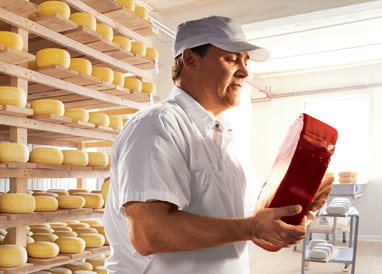Top Cheese Makers in Melbourne: The Story of Floridia Cheese Thomastown
Top Cheese Makers in Melbourne: The Story of Floridia Cheese Thomastown
Blog Article
Unlocking the Keys of Artisanal Cheese Making: A Step-by-Step Do It Yourself Overview
In the world of culinary workmanship, artisanal cheese making stands as a testament to the delicate equilibrium in between tradition and development. Each step in the process, from choosing the right milk to refining aging techniques, holds within it a riches of understanding gave with generations. As we start this trip to debunk the art of creating charming cheeses, we are confronted with a tapestry of tricks and abilities waiting to be untangled. Join us as we explore the complexities of this old craft, where perseverance, scientific research, and art merge to create tastes that tantalize the detects.
Picking the Right Milk
When starting the trip of artisanal cheese production, the selection of milk plays a crucial role in determining the quality and qualities of the end product. The kind of milk selected impacts the flavor, texture, and in general profile of the cheese. Raw milk, directly from the pet, is favored by many artisanal cheesemakers because of its distinct blend of enzymes, microorganisms, and flavor compounds. Utilizing raw milk comes with threats and guidelines, making sterilized milk a more secure option for novices.
In addition, the source of the milk, whether from cows, goats, sheep, or buffalo, contributes unique tastes and characteristics to the cheese. Each type of milk brings its very own subtleties, allowing for a broad variety of cheese selections to be crafted based on the picked milk.
Culturing and Coagulating
To launch the cheese-making procedure, the essential steps of culturing and coagulating need to be meticulously implemented to transform milk into curds and whey. Culturing involves introducing advantageous germs to the milk, which then begins the fermentation process. These germs convert lactose (milk sugar) into lactic acid, creating the acidic environment required for coagulation. The kind of culture utilized can substantially affect the taste, appearance, and ripening of the last cheese item.

The timing and temperature level control throughout culturing and coagulation are vital variables that influence the final end result of the cheese. Proper implementation of these steps is vital to guarantee the wanted structure, flavor, and consistency of the artisanal cheese being generated.
Draining and Pushing Curds
After the milk proteins have actually coagulated and the curds have been reduced to release whey, the following important action in artisanal cheese making entails draining and pushing the curds to accomplish the desired structure and consistency of the final cheese product. Draining pipes is the procedure of separating the curds from the whey. This can be done by transferring the curds into a cheesecloth-lined bowl-shaped sieve or mold and permitting the whey to drain off normally. The time for draining pipes can vary depending upon the kind of cheese being made and the desired wetness web content.
When the curds have actually sufficiently drained, the next action is pushing. Pushing helps remove any type of continuing to be whey and compacts the curds to form a solid cheese wheel. Pressing can be done utilizing specialized cheese presses that use consistent and gentle pressure over a time period. The duration and pressure used throughout pushing will certainly influence the final texture of the cheese, from luscious and soft to tough and company. Correct draining pipes and pressing are essential steps that substantially affect the top quality and features of the artisanal cheese being generated.
Aging and Flavoring Techniques
Implementing thorough aging and flavor methods is essential in improving the depth and complexity of artisanal cheeses, boosting their preference profiles to splendid levels of refinement and refinement. Aging plays a crucial duty in creating the special flavors and textures that identify artisanal cheeses. Throughout the aging process, cheeses are saved in meticulously managed environments where factors such as temperature level, air flow, and humidity are manipulated to urge the development of valuable molds and microorganisms. This controlled atmosphere allows celebrity to develop slowly, creating rich flavors and complicated aromas.
Flavoring strategies also contribute substantially to the last taste of artisanal cheeses. Cheesemakers may select to present additional flavors by including ingredients such as herbs, seasonings, and even fruits into the cheese during the manufacturing procedure. In addition, some cheeses are washed or rubbed with different fluids, such as salt water or alcohol, to boost their tastes and textures.
Wrapping and Keeping Cheeses

Verdict
In final thought, mastering the art of artisanal cheese making involves meticulously picking the best milk, complying with specific culturing and coagulating procedures, draining and pushing curds successfully, and using various aging and flavor techniques. Keep in mind to wrap and store your cheeses appropriately to make certain optimal flavor and appearance growth.
Each type of milk brings its own nuances, allowing for a vast array of cheese varieties to be crafted based on the chosen milk.After the milk proteins have actually coagulated and the curds have actually been cut to release whey, the following crucial action in artisanal cheese making includes draining pipes and pushing the curds to accomplish the wanted appearance and uniformity of the last cheese product. The majority of cheeses need to be covered in wax paper or cheese paper to enable them to take a breath while shielding them from drying out. For cheeses that need to continue aging, such as bloomy skins or cleaned rinds, ensure they are stored in an amazing setting like a cheese cave or a fridge set to the suitable temperature level. By paying interest to the wrapping and storage of artisanal cheeses, cheese makers and fanatics can preserve the integrity of these specials the original source and fully enjoy their complicated tastes.
Report this page